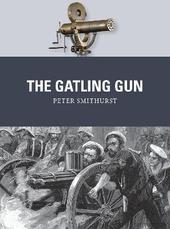
|
The Gatling Gun
Paperback / softback
Main Details
| Title |
The Gatling Gun
|
| Authors and Contributors |
By (author) Peter Smithurst
|
|
Illustrated by Johnny Shumate
|
| Series | Weapon |
|---|
| Physical Properties |
| Format:Paperback / softback | | Pages:80 | | Dimensions(mm): Height 248,Width 184 |
|
| ISBN/Barcode |
9781472805973
|
| Classifications | Dewey:355.82424 |
|---|
| Audience | |
|---|
| Illustrations |
30 b/w; 34 col
|
|
Publishing Details |
| Publisher |
Bloomsbury Publishing PLC
|
| Imprint |
Osprey Publishing
|
| Publication Date |
20 May 2015 |
| Publication Country |
United Kingdom
|
Description
A unique chapter in the history of firearms, the multibarrel, hand-cranked Gatling gun was one of the first practical rapid-fire weapons ever to be used in battle. It changed warfare by introducing the capability to project deadly, high-intensity fire on the battlefield, and portended the devastation that automatic weapons would wreak in World War I. During its 50-year career, it saw widespread service with US, British, and other forces on a host of battlefields through conflicts in Zululand and the American West, to the Spanish-American War. Although it saw widespread use in the hands of industrialized nations against various groups of indigenous native warriors, it was famously left behind by Custer at the battle of the Little Bighorn, where some argue it could have made all the difference. Featuring full-colour artwork plus contemporary and close-up photographs, this engaging study investigates the origins, development, combat use, and lasting influence of the formidable Gatling gun.
Author Biography
Peter Smithurst worked for several years at the Royal Armouries, Leeds, where he was a Senior Curator of Firearms and is now retired as Curator Emeritus. He has been elected a Visiting Research Fellow at the University of Huddersfield and is the author of The Pattern 1853 Enfield Rifle. Johnny Shumate works as a freelance illustrator living in Nashville, Tennessee. Most of his work is rendered in Adobe Photoshop using a Cintiq monitor. His greatest influences are Angus McBride, Don Troiani, and Edouard Detaille.
|